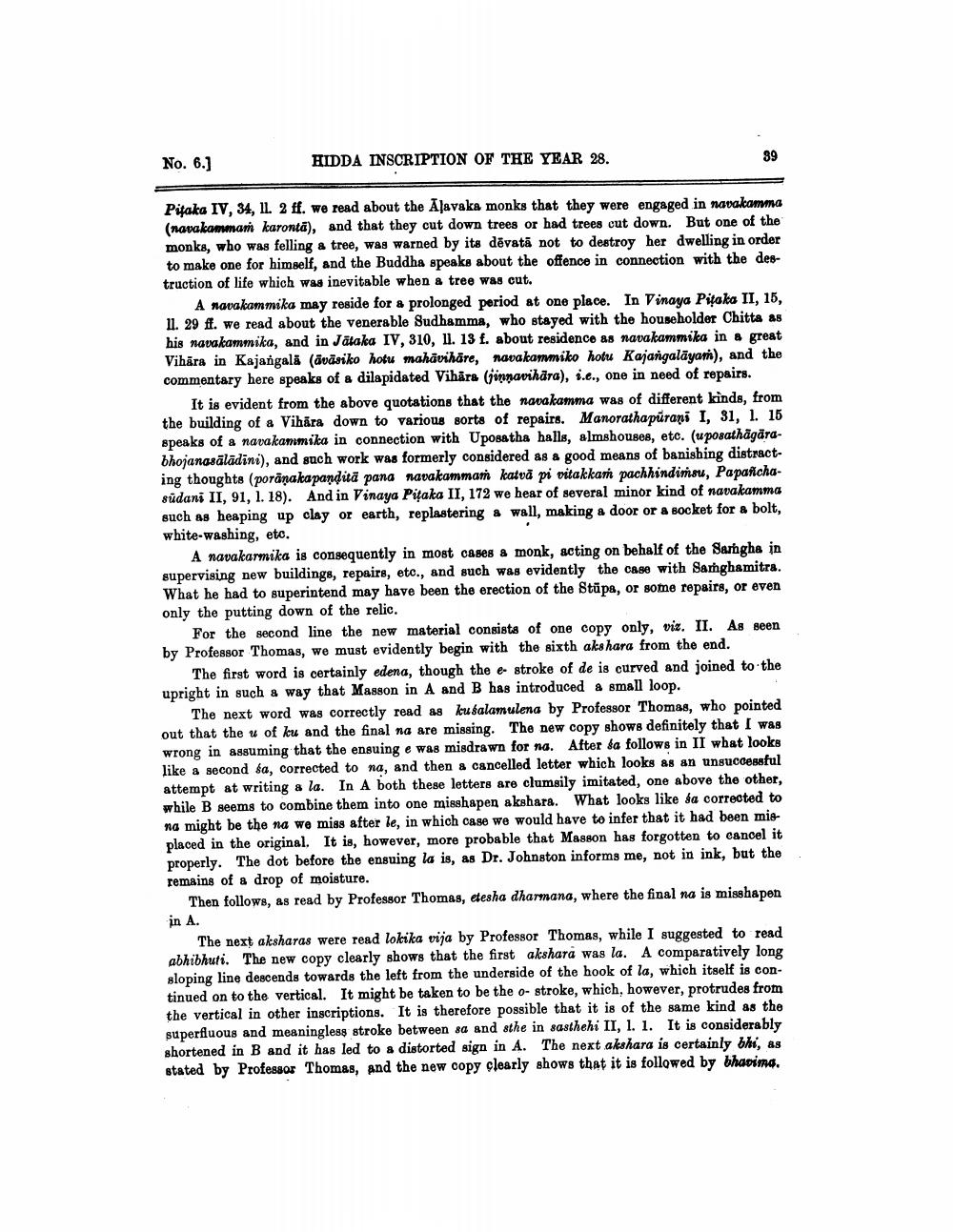________________
No. 6.)
HIDDA INSCRIPTION OF THE YEAR 28.
Pitaka IV, 34, 11. 2 ff. we read about the Alavaka monks that they were engaged in navakamma (navakammari karontā), and that they cut down trees or had trees cut down. But one of the monks, who was felling a tree, was warned by its dēvatā not to destroy her dwelling in order to make one for himself, and the Buddha speaks about the offence in connection with the destruction of life which was inevitable when a tree was cut.
A navakammika may reside for a prolonged period at one place. In Vinaya Pițaka II, 15, 11. 29 ft. we read about the venerable Sudhamma, who stayed with the householder Chitta as his navakanmika, and in Jätaka IV, 310, 11, 13 f. about residence as navakammika in & great Vihara in Kajangala (äväsiko hotu mahāvihäre, navakanmiko hotu Kajangalāyan), and the commentary here speaks of a dilapidated Vihara (jinnavihara), i.e., one in need of repairs.
It is evident from the above quotations that the navakamma was of different kinds, from the building of a Vihara down to various sorts of repairs. Manorathapūrani I, 31, 1. 15 speaks of a navakanumika in connection with Uposatha halls, almshouses, etc. (uposathāgarabhojanasālādini), and such work was formerly considered as a good means of banishing distracting thoughts (porānakapandita pana navakamman katrā pi vitakkan pachhindińsu, Papafichasüdani II, 91, 1. 18). And in Vinaya Pitaka II, 172 we hear of several minor kind of navakamma such as heaping up clay or earth, replastering & wall, making a door or & socket for a bolt, white-washing, etc.
A navakarmika is consequently in most cases a monk, acting on behalf of the Samgha in supervising new buildings, repairs, etc., and such was evidently the case with Sarghamitra. What he had to superintend may have been the erection of the Stūpa, or some repairs, or even only the putting down of the relic.
For the second line the new material consists of one copy only, viz. II. As seen by Professor Thomas, we must evidently begin with the sixth akshara from the end.
The first word is certainly edena, though the e- stroke of de is curved and joined to the upright in such & way that Masson in A and B has introduced a small loop.
The next word was correctly read as kusalamulena by Professor Thomas, who pointed out that the u of ku and the final na are missing. The new copy shows definitely that I was wrong in assuming that the ensuing e was misdrawn for na. After sa follows in II what looks like a second ta, corrected to na, and then a cancelled letter which looks as an unsuccessful attempt at writing a la. In A both these letters are clumsily imitated, one above the other, while B seems to combine them into one misshapen akshara. What looks like da corrected to na might be the na we miss after le, in which case we would have to infer that it had been mieplaced in the original. It is, however, more probable that Masson has forgotten to cancel it properly. The dot before the ensuing la is, as Dr. Johnston informs me, not in ink, but the remains of a drop of moisture.
Then follows, as read by Professor Thomas, etesha dharmana, where the final na is misshapen in A.
The next aksharas were read lokika vija by Professor Thomas, while I suggested to read abhibhuti. The new copy clearly shows that the first akshara was la. A comparatively long sloping line descends towards the left from the underside of the hook of la, which itself is continued on to the vertical. It might be taken to be the o- stroke, which, however, protrudes from the vertical in other inscriptions. It is therefore possible that it is of the same kind as the superfluous and meaningless stroke between 8a and 8the in sasthehi II, 1. 1. It is considerably shortened in B and it has led to a distorted sign in A. The next akshara is certainly bhi, as stated by Professor Thomas, and the new copy clearly shows that it is followed by bhadima.




